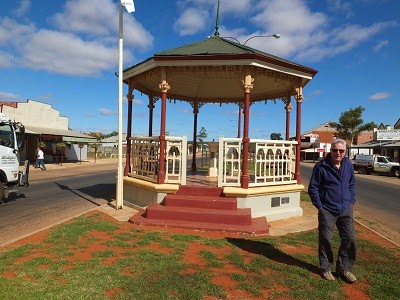25th May 2014
Gold was found at Coolgardie in 1892 and the population went from zero to 15,000 in just a few years. Confidence was high so many substantial fine buildings were erected between 1893 and 1900. Coolgardie had high hopes for itself, including the belief they should be the state capital instead of Perth. By the late 1890's it was clear the goldfield at Kalgoorlie, only 35km away, was richer and many miners packed up their possessions and went there instead.
Coolgardie's growth slowed and the mining eventually ceased in 1963. It is now lost in a time warp, not a ghost town exactly but not much going on either. Fortunately many of the fine buildings remain. They are built from a combination of locally fired bricks made with rock dust left over from the crushing process and a beautiful pink sandstone quarried from an area to the north. Nowadays there are many active gold mines in the area due to improved recovery techniques, but the employees choose mostly to live in Kalgoorlie.
 |
| Wardens Court Building 1898 |
Water was always a problem in this arid area. The few natural waterholes were soon inadequate, bore water is very saline and the annual rainfall is very low. Water was carted great distances and also condensed from bore water using wood fired boilers. This soon depleted all the trees for miles around. Shortly before the life saving 'golden pipeline' was installed from the hills east of Perth in 1903 water was selling for 5 shillings a gallon, which by weight was higher than the price of gold at that time. The same pipeline carried water to Kalgoorlie and allowed that town to flourish.
A feature of all these outback towns is the enormously wide streets. In the arid areas it is because they had to be wide enough for a camel train to turn around. Camels were introduced from Afghanistan and were the major form of transport in desert areas until the arrival of railways. In the eastern states the roads are similarly wide, in that case it was a bullock team to be turned around.
The railway arrived in 1896 but has long since been re routed to the north. We found an old steam train complete with 1st and 2nd class carriages and a goods van on the platform. The goods van included an insulated area with meat hooks in the ceiling for keeping the perishables cool on the journey from Perth. It would be great if the money and enthusiasm of volunteers could be found to restore it all one day.
 |
| Coolgardie Railway station 1896 |
Most of the miners lived in whatever they could find, usually a tent to start with but as money was made and materials could be found they added a tin roof and tin walls. Boiling in summer and freezing in winter. By contrast the Warden [also Magistrate] lived in a well designed house on one of the few hills around. The house, circa 1895, was designed and built as a government contract by the Bunnings brothers [yes, of Bunnings Warehouse fame]. They were 18 and 19 years old at the time. Now in the hands of the National Trust, the house is superbly designed with 45cm thick outside walls and 30cm thick internal walls constructed from the local pink sandstone. These combined with wraparound verandahs, louvred breezeways and a roof lantern served to keep the house beautifully cool in the summer and would have provided some insulation in the winter.
 |
| Warden Finnerty's Residence |
We arrived back in Kalgoorlie mid afternoon expecting to do a top up grocery shop before heading into the sparsely populated north. However, everything, including Coles and Woolworths supermarkets closes on Sunday! This place really is a frontier town. We will have to go tomorrow morning before setting off, tomorrow is a relatively short drive anyway.

















































